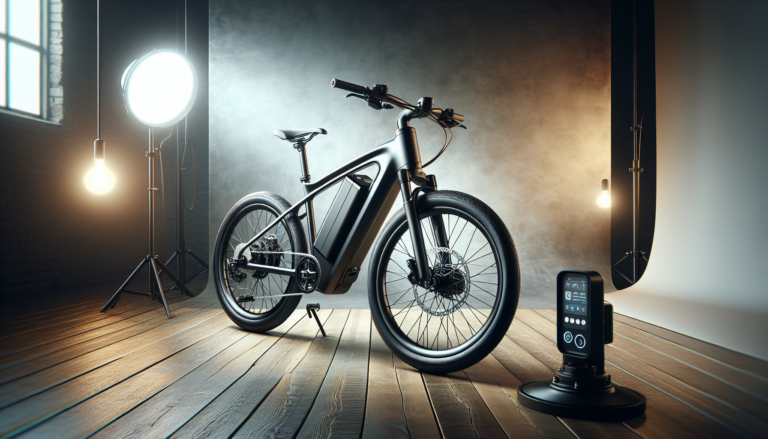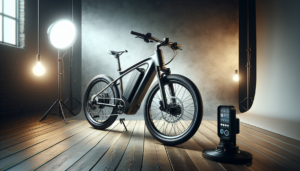Introduction to E-Bikes
An electric bicycle, also known as an e-bike, is a bicycle equipped with an electric motor that assists the rider while pedaling. E-bikes have gained popularity in recent years as a convenient, eco-friendly, and fun mode of transportation. They offer the benefits of traditional cycling while providing an extra boost of power when needed, making it easier to tackle hills, headwinds, and longer distances.
What is an E-Bike?
At its core, an e-bike is a regular bicycle with three additional components: a motor, a battery, and a controller. The motor provides additional propulsion to assist the rider, the battery powers the motor, and the controller allows the rider to manage the level of electric assistance. E-bikes integrate these electrical components into traditional bike designs, enhancing human power for an easier and more enjoyable riding experience.
E-bikes come in a variety of styles, from commuter-friendly city bikes to rugged mountain bikes, catering to different riding preferences and needs. They also offer multiple levels of assistance, allowing riders to choose how much power they want the motor to provide.
History and Evolution of E-Bikes
The concept of electric bicycles dates back to the late 19th century, with various patents and prototypes emerging in the United States and Europe. However, it wasn’t until the 1990s that e-bikes began to gain traction, particularly in China, where they became a popular alternative to gasoline-powered scooters.
Over the years, advancements in battery technology, motor efficiency, and design have led to significant improvements in e-bike performance and affordability. Today’s e-bikes are lighter, more powerful, and offer longer ranges than ever before, making them an increasingly attractive option for commuters, recreational riders, and cycling enthusiasts alike.
Components of an E-Bike
To understand how an e-bike works, it’s essential to know about its three main components: the motor, the battery, and the controller. Each plays a crucial role in providing electric assistance to the rider.
The Motor
The motor is the heart of an e-bike, providing the additional propulsion that assists the rider. E-bike motors come in various power ratings, typically ranging from 200W to over 1,000W. In the United States, the legal limit for motor power is 750W, while in the United Kingdom, regulations limit motor output to 250W.
There are two main types of motors used in e-bikes: hub motors and mid-drive motors. Hub motors are located in the center of the front or rear wheel and directly power the wheel. They are generally less expensive and easier to maintain but can be less efficient on varied terrain. Mid-drive motors, on the other hand, are located at the bike’s bottom bracket and transfer power through the chain to the rear wheel. Mid-drive motors often provide better performance, as they can take advantage of the bike’s gears.
The Battery
The battery is another critical component of an e-bike, as it powers the motor and significantly affects the bike’s weight, style, and range. There are two main types of batteries used in e-bikes: sealed lead-acid (SLA) and lithium-ion.
SLA batteries are less expensive but are also heavier, have a shorter lifespan, and require more maintenance. Lithium-ion batteries, while more costly, are lighter, last longer, and have a higher energy density, allowing for longer ranges. The capacity of an e-bike battery is measured in watt-hours (Wh), with higher capacities generally providing longer ranges.
The Controller
The controller is the brain of the e-bike, managing the power delivered from the battery to the motor based on the rider’s input. Controllers can be pedal-activated, meaning the motor engages when the rider begins pedaling, or throttle-based, allowing the rider to control the motor’s power output using a twist grip or thumb throttle.
Most e-bikes also feature a display or control panel on the handlebars, allowing the rider to adjust the level of assistance, monitor battery life, and view other ride data. Some advanced controllers even offer features like regenerative braking, which recharges the battery while braking, and smartphone connectivity for customizing settings and tracking rides.
E-Bike Modes
E-bikes typically offer multiple riding modes, allowing riders to choose the level of assistance provided by the motor. The two most common modes are pedal-assist and electric-only.
Pedal-Assist Mode
In pedal-assist mode, also known as pedelec mode, the motor provides additional power to complement the rider’s pedaling. The level of assistance can often be adjusted, with lower levels providing a gentle boost and higher levels offering more substantial support. Pedal-assist mode is designed to enhance the riding experience, making it easier to climb hills, accelerate, and maintain higher speeds for longer periods.
Many e-bikes use torque sensors to measure the rider’s pedaling effort and adjust the motor’s power output accordingly. This creates a natural and intuitive riding feel, as the motor’s assistance seamlessly blends with the rider’s own pedaling power.
Electric-Only Mode
Some e-bikes also offer an electric-only mode, also known as throttle mode, which allows the rider to operate the bike solely on electric power without pedaling. In this mode, the rider controls the motor’s output using a twist grip or thumb throttle, similar to how a motorcycle or scooter operates.
Electric-only mode can be useful for getting a quick burst of speed, navigating crowded areas, or simply taking a break from pedaling. However, it’s important to note that using electric-only mode will drain the battery more quickly than pedal-assist mode, resulting in shorter overall ranges.
| Country/Region | Speed Limit for Electric Assistance |
|---|---|
| United States | 20 mph (32 km/h) |
| European Union | 25 km/h (15.5 mph) |
| United Kingdom | 25 km/h (15.5 mph) |
| Australia | 25 km/h (15.5 mph) |
It’s crucial to be aware of local regulations regarding e-bike speed limits and motor power output, as these can vary by country and region.
Types of E-Bikes
E-bikes come in a wide range of styles and designs, catering to various riding preferences and purposes. Some of the most popular types of e-bikes include:
Electric Cargo Bikes
Electric cargo bikes are designed to carry heavy loads, such as groceries, packages, or even children. They typically feature a large cargo area, either in front of the rider or behind, and are equipped with a powerful motor to assist with the added weight. Cargo e-bikes are popular among families, businesses, and anyone who needs to transport goods by bike.
Electric Mountain Bikes
Electric mountain bikes, or eMTBs, are designed for off-road riding and feature robust frames, wide tires, and suspension systems to handle rough terrain. They are equipped with powerful motors, often mid-drive, to assist riders in tackling steep climbs and navigating challenging trails. eMTBs have gained popularity among mountain bikers looking to extend their rides and access more terrain.
Electric Road Bikes
Electric road bikes are designed for speed and efficiency on paved surfaces. They often feature lightweight frames, narrow tires, and drop handlebars, similar to traditional road bikes. The motor and battery are usually integrated into the frame for a sleek and aerodynamic design. Electric road bikes are popular among commuters and fitness enthusiasts looking for a faster and more efficient ride.
Electric Hybrid Bikes
Electric hybrid bikes combine features of road and mountain bikes, offering a versatile option for various riding conditions. They typically have flat handlebars, medium-width tires, and a relaxed geometry for a comfortable and upright riding position. Electric hybrid bikes are popular among commuters and recreational riders who want a bike that can handle city streets, bike paths, and light off-road trails.
Electric Folding Bikes
Electric folding bikes are designed for urban commuters who need a compact and portable option. They feature a folding frame and smaller wheels, allowing them to be easily folded and stored in tight spaces, such as apartments, offices, or public transportation. Electric folding bikes are equipped with a motor and battery to assist with pedaling, making commutes faster and less strenuous.
Performance and Range
When considering an e-bike, two of the most important factors to evaluate are performance and range. Understanding how these aspects impact the riding experience can help you choose the right e-bike for your needs.
Factors Affecting Range
The range of an e-bike refers to the distance it can travel on a single battery charge. Several factors can influence an e-bike’s range, including:
- Battery capacity: Higher-capacity batteries generally provide longer ranges.
- Motor power: More powerful motors may consume battery power more quickly, reducing range.
- Riding mode: Using higher levels of assistance or electric-only mode will drain the battery faster than lower assistance levels or pedal-only mode.
- Terrain: Hilly or rough terrain requires more power from the motor, which can reduce range.
- Rider weight: Heavier riders may require more power from the motor, impacting range.
- Weather conditions: Strong headwinds, extreme temperatures, and wet conditions can all affect battery performance and range.
Typical Range Expectations
The range of an e-bike can vary greatly depending on the factors mentioned above, but most e-bikes offer a range between 20 and 100 miles on a single charge. It’s essential to consider your typical riding distances and conditions when selecting an e-bike to ensure it meets your range requirements.
Keep in mind that e-bike batteries can be expensive to replace, so it’s essential to take good care of your battery to maximize its lifespan. This includes storing it in a cool, dry place, avoiding extreme temperatures, and following the manufacturer’s charging and maintenance guidelines.
E-Bike Safety and Maintenance
As with any vehicle, safety and proper maintenance are crucial when it comes to e-bikes. By following best practices and regularly caring for your e-bike, you can ensure a safe and enjoyable riding experience.
Safety Tips for E-Bike Riders
- Always wear a helmet and other protective gear, such as gloves and eye protection.
- Follow traffic laws and ride predictably, using hand signals when turning or stopping.
- Be aware of your surroundings and watch for obstacles, pedestrians, and other vehicles.
- Use lights and reflective gear when riding in low-light conditions.
- Maintain a safe speed and control, especially when riding in crowded areas or on unfamiliar terrain.
- Regularly inspect your e-bike for any signs of wear, damage, or loose components.
Regular Maintenance Practices
To keep your e-bike in top condition and ensure its longevity, regular maintenance is essential. Some key maintenance practices include:
- Cleaning and lubricating the chain, gears, and other moving parts.
- Checking tire pressure and inspecting tires for wear or damage.
- Testing brakes and replacing brake pads when necessary.
- Inspecting the frame, handlebars, and other components for cracks or damage.
- Checking electrical connections and ensuring the battery is properly secured and functioning.
- Following the manufacturer’s guidelines for battery care and charging.
- Scheduling regular professional tune-ups and service, especially for the motor and electrical components.
By staying on top of maintenance and addressing any issues promptly, you can minimize the risk of accidents and ensure your e-bike remains reliable and efficient.
E-Bike Insurance and Accessories
As e-bikes gain popularity, it’s essential to consider insurance options and accessories that can enhance your riding experience and protect your investment.
Why You Need E-Bike Insurance
E-bike insurance can provide valuable protection against theft, damage, and liability. While some homeowners or renters insurance policies may cover e-bikes, it’s essential to check with your insurance provider to understand your specific coverage and any limitations.
Specialized e-bike insurance policies can offer more comprehensive coverage, including:
- Theft protection, even if the e-bike is stolen away from home.
- Damage coverage for accidents, vandalism, or other incidents.
- Liability protection in case you injure someone or damage property while riding your e-bike.
- Roadside assistance in case of a breakdown or flat tire.
Given the significant investment e-bikes represent, having proper insurance coverage can provide peace of mind and financial protection in the event of an unexpected incident.
Popular E-Bike Accessories
There are numerous accessories available to enhance your e-bike riding experience, increase comfort, and add functionality. Some popular e-bike accessories include:
- Helmets: A high-quality, well-fitting helmet is essential for safe riding.
- Locks: Sturdy locks can help prevent theft when parking your e-bike in public areas.
- Fenders: Fenders can protect you and your e-bike from water, mud, and debris kicked up from the tires.
- Racks and baskets: These accessories allow you to carry cargo, such as groceries or work bags, more easily.
- Lights: High-visibility lights can improve your safety when riding in low-light conditions.
- Suspension seatposts: These can add comfort by absorbing shocks and vibrations from the road.
- GPS trackers: These devices can help locate your e-bike if it’s stolen.
When selecting accessories for your e-bike, make sure they are compatible with your specific model and don’t interfere with the motor, battery, or other components.
Conclusion
Electric bicycles, or e-bikes, have revolutionized the way people approach cycling, offering a convenient, eco-friendly, and fun mode of transportation. By integrating a motor, battery, and controller into traditional bike designs, e-bikes provide riders with an extra boost of power, making it easier to tackle hills, headwinds, and longer distances.
With a wide range of styles, from commuter-friendly city bikes to rugged mountain bikes, e-bikes cater to various riding preferences and needs. They also offer multiple levels of assistance, allowing riders to choose how much power they want the motor to provide, making the riding experience highly customizable.
As e-bike technology continues to advance, these innovative vehicles are becoming increasingly accessible and attractive to a growing number of people. Whether you’re a commuter looking to make your daily trips faster and less strenuous, a recreational rider seeking to expand your cycling horizons, or a cycling enthusiast interested in exploring new terrains, an e-bike may be the perfect solution.
By understanding the key components, modes, and types of e-bikes, as well as the factors affecting performance and range, you can make an informed decision when selecting the right e-bike for your needs. Additionally, prioritizing safety, proper maintenance, and considering insurance and accessories can help ensure a safe, enjoyable, and long-lasting e-bike experience.






